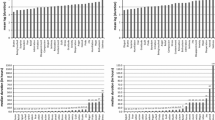Abstract
In a number of retrospective studies it has been found that the duration of emotional experience is highly variable and several determinants that account for this variability have been identified. However, two issues that may have consequences for the measurement of emotion duration have been left unaddressed. First, it is unclear whether people are capable of remembering the duration of their actual emotional experience. Second, it is uncertain whether estimates of the duration of emotional experience are influenced by the format of the response scale. Participants watched joy- and sadness-sustaining movie fragments of different durations. At the end of the day they were asked to estimate the duration of each fragment or the duration of their emotions during each fragment on a relatively short-range or long-range scale. Regardless of whether fragment or emotion duration was estimated, estimates were (a) largely accurate and (b) higher on long-range compared to short-range scales.
Similar content being viewed by others
References
Agresti A.: Categorical Data Analysis. Wiley, New York (2002)
Campbell L.A., Bryant R.A.: How time flies: a study of novice skydivers. Behav. Res. Ther. 45, 1389–1392 (2007
Davidson R.J.: Affective style and affective disorders: perspectives from affective neuroscience. Cogn. Emot. 12, 307–330 (1998)
De Boeck P., Wilson M.: Explanatory Item Response Models. Springer, New York (2004)
Eaton L.G., Funder D.C.: Emotional experience in daily life: valence, variability, and rate of change. Emotion 1, 413–421 (2001)
Efron B., Tibshirani R.J.: An Introduction to the Bootstrap. Chapman and Hall, New York (1993)
Frijda N.H.: The Laws of Emotion. Erlbaum, Mahwah (2007)
Hemenover S.H.: Individual differences in rate of affect change: studies in affective chronometry. J. Personal. Soc. Psychol. 85, 121–131 (2003)
Kellarirs J.J., Kent R.J.: The influence of music on consumers’ temporal perceptions: Does time fly when you’re having fun?. J. Consum. Psychol. 1, 365–376 (1992)
Kellarirs J.J., Mantel S.P.: The influence of mood and gender on consumers’ time perceptions. Adv. Consum. Res. 21, 514–518 (1994)
Loftus E.F., Schooler J.W., Boone S.M., Kline D.: Time went by so slowly: overestimation of event duration by males and females. Appl. Cogn. Psychol. 1, 3–13 (1987)
Menon G., Raghubir P., Schwarz N.: Behavioral frequency judgments: an accessibility-diagnosticity framework. J. Consum. Res. 22, 212–228 (1995)
Schacter D.L.: The seven sins of memory. Am. Psychol. 54, 182–203 (1999)
Scherer K.R., Wallbott H.G.: Evidence for universality and cultural variation of differential emotion response patterning. J. Personal. Soc. Psychol. 66, 310–328 (1994)
Schimmack U., Oishi S., Diener E., Suh E.: Facets of affective experiences: a framework for investigations of trait affect. Personal. Soc. Psychol. Bull. 26, 655–668 (2000)
Schwartz N.: Self reports: how the questions shape the answers. Am. Psychol. 54, 93–105 (1999)
Schwartz N., Scheuring B.: Judgments of relationship satisfaction: inter- and intraindividual comparison strategies as a function of questionnaire structure. Eur. J. Soc. Psychol. 18, 485–496 (1988)
Schwartz N., Scheuring B.: Selbstberichtete verhaltens- und symptomhäufigkeiten: Was befragte aus anwortvorgaben des fragebogens lernen [frequency reports of psychosomatic symptoms: what respondents learn from response alternatives]. Z. Klin. Psychol. 22, 197–208 (1992)
Sonnemans, J.: Structure and determinants of emotional intensity. Unpublished Doctoral Dissertation, University of Amsterdam (1991)
Verduyn P., Delvaux E., Van Coillie H., Tuerlinckx F., Van Mechelen I.: Predicting the duration of emotional experience: two experience sampling studies. Emotion 9, 83–91 (2009)
Verduyn P., Van Mechelen I., Tuerlinckx F., Meers K., Van Coillie H.: Intensity profiles of emotional experience over time. Cogn. Emot. 23, 1427–1443 (2009)
Verduyn P., Van Mechelen I., Tuerlinckx F.: The relation between event processing and the duration of emotional experience. Emotion 11, 20–28 (2011)
Vierordt K.: Der Zeitsinn nach Versuchen [the time sense after attempts]. H. Laupp, Tubingen (1868)
Yarmey A.D.: Retrospective duration estimations for variant and invariant events in field situations. Appl. Cogn. Psychol. 4, 45–57 (2000)
Author information
Authors and Affiliations
Corresponding author
Rights and permissions
About this article
Cite this article
Verduyn, P., Tuerlinckx, F. & Van Gorp, K. Measuring the duration of emotional experience: the influence of actual duration and response format. Qual Quant 47, 2557–2567 (2013). https://doi.org/10.1007/s11135-012-9671-x
Published:
Issue Date:
DOI: https://doi.org/10.1007/s11135-012-9671-x




